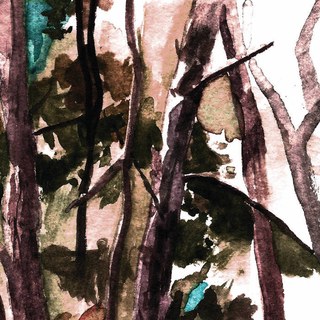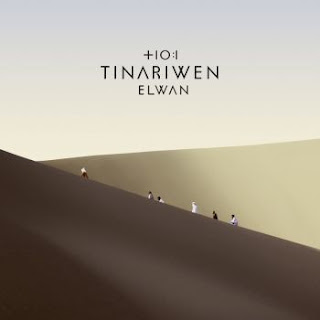My year was spent rekindling a long lost interest in music on vinyl and diving deep into the back catalogue of blues and jazz artists who made their art many years before I knew how much their music meant to American culture. Jazz vocalists like Ella Fitzgerald, Sarah Vaughan, Dinah Washington and Nina Simone were in heavy rotation on my turntable. More than half the nights of the year I drifted to sleep listening to John Coltrane, Miles Davis or Chet Baker. Drives around Philadelphia or on two long road trips to Charleston and New Orleans were accompanied on my Ipod by Howlin' Wolf, Muddy Waters and a wide array of Atlantic or Stax/Volt soul artists like Wilson Pickett, Otis Redding, Aretha Franklin and Curtis Mayfield.
I am not certain why my musical tastes have gravitated towards these classic jazz and blues artists of the '40s, '50s and '60s but I suspect the hardships of their lives and the uncertainty of growing up in Jim Crow America speak to me in ways that the modern hang-ups and complaints of Ariana Grande and Lizzo just don't.
It's probably not surprising that much of the new music I enjoyed this year was recorded by artists who were also dealing with their own issues of mortality or personal tragedy. Some were making observations about the state of political affairs in America that reflected the despair so many Americans presently feel. Equally unsurprising is that nearly half of the artists on my 2019 list are in their 50s and 60s and their concerns are mine as well. The music I felt the most was steeped in wisdom and self-reflection. Ultimately, their songs lifted my spirits and gave me hope for the future, even if the songs reflected themes of personal angst about despairing circumstances. Maybe they are the kinds of songs we gravitate to as we become older.
We are living in hard times now and they may become harder in the coming months. But these are ten great albums (and ten others nearly as great) that might help you make it through the trials that lay before us.
1. "Tales of America" -- J.S. Ondara
I don't know why my favorite record of the year is not appearing on other ten bests lists for 2019. J.S. Ondara was born in Nairobi, Kenya and the first time I heard him, he told the audience he decided to move to Minneapolis because it was near the birthplace of Bob Dylan, whose songs influenced him as a teenager. It would be wrong to tag Ondara a "protest singer" but his observations of life in his adopted country are thought-provoking and pointed. Like Dylan, he brings a writer's eye for details to his songs. "Tales of America" was the record I heard more than any other this year and it continues to reveals its simple pleasures whenever I play it again. I saw him perform most of the songs on this incredible debut four times this year, three times performing solo and once with a two-piece rhythm section supporting him. The first time I heard him I thought I was listening to Tracy Chapman. His voice is magical, light and emotive that slips occasionally into a high falsetto that is spine tingling. Like Chapman's debut, this one feels like an instant classic. It also feels like a moment it time that reflects the era we're living in better than any record I heard this year: an immigrant's wry and knowing observations of his new chosen homeland.
2. "Ghosteen" -- Nick Cave and the Bad Seeds
Cave's 2019 album is a follow up to "The Skeleton Key," which was recorded three years ago following the tragic death of his 15-year-old son. Like that album, this one is wrought from the rough emotions of losing a child and it features the same ethereal vibe of minimalist melodies floating above Cave's spoken-word eulogies. In the title song, Cave asserts "This world is beautiful / held within its stars / I keep it in my heart / the stars are your eyes / I loved them right from the start / a world so beautiful / and I keep it in my heart." Many of the songs drop religious imagery and references that give the record the spirit of church hymns. It's a deeply spiritual journey; a series of love letters to his departed son; a moving testimony to the eternal love between a father and his child.
3. "Sonocardiogram" -- Dayme Arocena
Think of Dayme Arocena as Cuba's answer to Aretha Franklin. Big voice, big sound, big talent...and equally deft vocal gymnastics when singing jazz, R&B or dance pop music with a distinctly Afro-Cuban beat. Her Tiny Desk video on YouTube will provide a great taste of her energetic live performances. All three of her albums are worth finding but the new one showcases an increasing desire to take chances in new genres, especially jazz. Arocena and her band wanted to capture the vibe of their live shows so they eschewed a recording studio and instead recorded the songs live in a one-room artists' studio in Havana without a producer. The immediacy of the record is apparent. A personal favorite is "Menuet Para Un Carazon", a tribute to Arocena's Cuban muse, singer Lupe Victoria Yamond, also known as "La Lupe." This was my favorite world music record of the year.
4. "The Gospel According to Water," Joe Henry.
Henry writes in his liner notes "these songs...bloomed quickly as I wrote them, growing most decidedly out of the black earth of a recent and alarming medical diagnosis," prostate cancer. The songs are elegantly accompanied mostly by Henry's own acoustic guitar playing. A small trio, with his son, Levon, playing tenor sax, joins him on several offerings. The album could fit equally snug in several genres, including folk, jazz and Americana. Henry's sincerity feels hard-earned and his lyrical observations speak the wisdom of a life-changing moment. "In Time for Tomorrow" and "Gates of Prayer Cemetary # 2" are two standout cuts, but the entire album will grow on you over time.
5. "Western Stars" - Bruce Springsteen
Bruce Springsteen's 2019 album, like Joe Henry's, feels more like a solo acoustic folk album than a rock and roll record. It's his best album since "The Rising." If "Nebraska" was Springsteen's nod to the stark American vision of Woody Guthrie's Dust Bowl era songs, this one feels like a nod to Dylan's "Nashville Skyline." It would not be fair to call this a country record but the song settings, the album art (a galloping pony on the front cover, the Boss in a cowboy hat leaning against a Dodge truck with California plates on the back) all suggest a cowboy aesthetic of the wide open West. Springsteen did not support "Nebraska"with a tour and it's likely the presence of orchestral strings on many of the songs on "Western Stars" suggests these songs, as they were produced on the record, will not be played on a tour either. Don't let that stop you from buying this one. It's a wonderful return to form for Springsteen.
6. "Deserted" -- Mekons
It's hard to imagine a band that was born out of the punk movement in Leeds in the mid-70s would still be creating relevant rock music more than 40 years later. Widely regarded as one of England's most visceral and exciting live bands ever, their show at Johnny Brenda's in July (my son accompanied me) did not disappoint. Luke was one of the youngest members of the audience and many of them were old timers who knew the lyrics to the new songs as well as the old. The record starts out with a rousing punk rocker, "Lawrence of California" that would likely make a "Best of the Mekons" should they ever decide to release one. (Fans as devoted to the band as I am usually insist they have too many great songs to compress the body of their work into a single album). "How Many Stars" shows the kinder, gentler ballad side to this incendiary collective. If you don't know them, Google them. Better yet, go see them. They'll rock your socks off.
I purposefully placed the Craft album near the Mekons record on this list because....you know, rock n' roll is here to stay. This second album by Craft sounds a lot like his first and one friend mentioned to me that seemed like a shortcoming. But he hasn't heard Craft and his band perform live. Straight ahead rock and roll doesn't seem to play well in today's marketplace of ideas, but if you love '70s era class rock, you'll enjoy this one. When I saw him this summer at a small club in South Philly, these songs ripped and roared and were impossible not to admire. They harken back to vintage Stones songs from the "Let It Bleed" / "Exile On Main Street" era. It's a freewheeling, exhilarating ride. If I get a knee replacement any time soon, I'd actually dance again to this band.
8. "Pony" -- Orville Peck.
Which was it to be: Orville Peck's debut album, "Pony" or Sturgill Simpson's new record that might occupy the "quasi-country" niche on my end of the year list? Simpson's new one is great and making a lot of noise on the best of the year lists but I've already placed three of his records on previous lists so I am giving the nod to the newcomer. A critic on the music website Clash explained Peck's peculiar charms this way. "Country is best when the music behind the singer isn't shouty or muscular but plays a supporting role. Artists like Parton, Cash, Haggard and Nelson have made their names with voices more so than melodies, production and musicianship, ….'Pony' is framed in that mold and offers a brilliant palate cleanser to the vast majority of overblown, raucous and vapid (country) compositions." If that sounds similar to Sturgill Simpson's achievements in the country genre, that's because they are both country iconoclasts.
9. "Purple Mountains" - David Berman.
Berman, formerly of the Silver Jews, left this one last masterpiece behind before taking his own life in August at the age of 52. Despite the inherent darkness and desperation of that decision, this album is chockful of the same kind of humorous and ironic touches that always embellished his sadsack persona as the Silver Jews frontman. I was unaware of this record until two weeks ago when Luke played it for me because he knew I was putting my 2019 list together. Good call. Knowing how it all ended for Berman doesn't diminish this last achievement in any way. Some may hear a cry of desperation in it. I hear something closer to a fond farewell to the world.
10. "Titanic Rising" -- Weyes Blood
Weyes Blood is a sly reference to Flannery O'Conner's novel, "Wise Blood", a nod to a literary master that's likely to appeal to rock critics. And sure enough, her aggregate score on Metacritic ranks number 2 on this year's list of top albums. Natalie Mering is the name of the artist and "Titanic Rising" is worthy of the acclaim. Comparisons to Judee Sill, Nina Simone and Annette Peacock feel appropriate. An artist worth watching.
Ten others worth considering. "Jaime" by Brittany Howard; "Kiwanuka" by Michael Kiwanuka; "Three Chords and the Truth," by Van Morrison; "There is No Other" by Rhiannon Giddens; "Sound and Fury" by Sturgill Simpson; "Norman F*cking Rockwell" by Lana Del Ray; "Butterfly" by Ali Awan; "Wild Card" by Miranda Lambert; "All Mirrors", by Angel Olsen; "A Distant Call," by Sheer Mag.













































